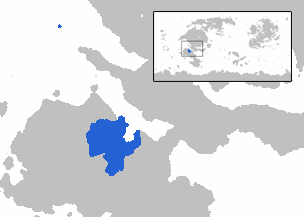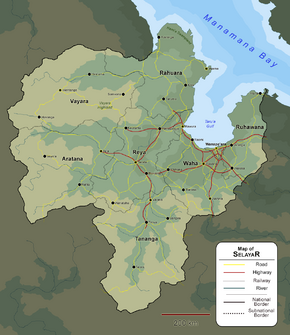Selayar: Difference between revisions
mNo edit summary |
(overview revamp) |
||
| Line 73: | Line 73: | ||
|calling_code = +73 | |calling_code = +73 | ||
}} | }} | ||
'''Selayar''' (/sə'laːjar/; [[Heraan language|Heraʻan]]: ''Heraʻā'' [ | '''Selayar''' (/sə'laːjar/; [[Heraan language|Heraʻan]]: ''Heraʻā'' ['heraʔaː]), officially the '''Monarchy of Selayar''' ([[Heraan language|Heraʻan]]: ''Watāhama mi Heraʻā''), is a federal monarchy located in northern Aurelia, bordering the Mananama Bay. It is located northeast of [[Rihan]] and northwest of [[Shffahkia]]. Selayar covers LAND AREA square kilometers and has an estimated population of 41,332,005 in 2015. Selayar comprises of 7 ''ʻArana'' (state-kingdom), 1 Federal City, and 1 Royal Capital City. Wanavera'a, officially the Royal Capital City of Wanavera'a, is the capital, while Mawura is the largest city in Selayar. | ||
Selayar is one of the most diverse countries on Eurth, owing to its location in the tropics. It's year-round hot and humid temperature along with its dense cover of untouched forests provide habitats for a large number of endemic species. The fertile floodplain on the north supports a dense and bustling population of Selayar, with many rivers flowing through from the Wananga mountains in the east. The floodplain alone hosts an almost three-fourth population of the nation. | Selayar is one of the most diverse countries on Eurth, owing to its location in the tropics. It's year-round hot and humid temperature along with its dense cover of untouched forests provide habitats for a large number of endemic species. The fertile floodplain on the north supports a dense and bustling population of Selayar, with many rivers flowing through from the Wananga mountains in the east. The floodplain alone hosts an almost three-fourth population of the nation. | ||
Selayar emerged as one of the earliest civilisations in Aurelia, beginning with the rise of Ninaman cultures in early first millennia BCE and the development of rice agriculture. Tenaia Kingdom is widely-recognised as the first major kingdom in Selayar, after uniting the Saraian Valley under its dominion around fourth century CE. The arrival of [[Shffahkia|Shffahkian]] colonist early in the 1400s brought many novel things to the kingdom, and with it, constant warfare. Only in the early sixteenth century, did Reyan Empire once again united the Valley, and went on an aggressive expansion campaign. The Empire reached its zenith in late 1790, spanning almost all of the southern Manamanan coast and land further inland, matched only by the Shffahkian Empire in the southeast. Selayar, as it is known now, grew out of the Wananan Rebellion in 1850, which shifted the power from Reyan capital Terata, to the former vassal of the Empire, Heraa. Selayar once again went on an expansionist campaign, only ended by the [[Selayari Civil War|Civil War]] that ravaged the country for more than a decade, starting in 1959, temporarily splitting the country into two governments. Reconciliation and reformation followed the post-Civil War period, though small-scale rebel activity persists. The election of King Manuwesa II as the ''Tāha'' is regarded as a transition to a new modern era of Selayar. | |||
The Economic Reform of 1974 is hailed as a breakthrough reformation in economic sector, as the virtually destroyed economy of Selayar rose up again as the "Tiger of Aurelia" in the late 1980s. Selayar's economy has seen an annual growth rate of more than 7 percent from the late 1970s, and well into the late 1990s. Oil price boom is regarded as the main factor in Selayar's economy recovery, along with the growing industrial base that followed decentralisation of Selayari economy. The annual growth rate has slowed down as the nation entered the 21st century, and with it, a decrease in oil production contribution to Selayar's economy. | |||
Selayar is a member of several multilateral organisations, including [[Manamanan League]]. There has been recent talk for the inclusion of Selayar into [[Aurelian League]]. | |||
==Etymology== | ==Etymology== | ||
| Line 99: | Line 103: | ||
==Geography== | ==Geography== | ||
[[File:Geographic Map of Selayar.png|thumb|left|290px|Geographic Map of Selayar]] | [[File:Geographic Map of Selayar.png|thumb|left|290px|Geographic Map of Selayar]] | ||
| Line 110: | Line 113: | ||
==Economy== | ==Economy== | ||
==Demography== | ==Demography== | ||
Revision as of 11:12, 30 July 2019
This article is incomplete because it is pending further input from participants, or it is a work-in-progress by one author. Please comment on this article's talk page to share your input, comments and questions. Note: To contribute to this article, you may need to seek help from the author(s) of this page. |
The Monarch of Selayar Watāhama mi Heraʻā (Heraʻa) | |
|---|---|
| Motto: Rimamura Wavanga "Prosperous Land" | |
| Anthem: Risutiva mu Heraʻā "Long Live Selayar" | |
 Area controlled by Selayar shown in blue | |
| Status | Independent State |
| Location | Northern Aurelia |
| Capital | Wanaveraʻa |
| Largest city | Mawura |
| Official languages | Heraʻan |
| Recognised regional languages | Reyan, Vanawan, Ruawese, Vayarese |
| Ethnic groups (2015) | |
| Religion | Aturātuʻa |
| Demonym(s) | Selayari |
| Government | Federal parliamentary elective constitutional monarchy |
• Monarch | Manuwesa II |
• Prime Minister | Huti Manaranga |
| Legislature | Varai mi Tama |
| Varai mi Taravanga | |
| Varai mi Ranga | |
| Establishment | |
• Wanana Rebellion | 1860 - 1865 |
• 18 August Revolution | 18 August 1897 |
• Selayari Succession Crisis | 1958 |
• Treaty of ʻArama | 1 December 1974 |
• Water (%) | negligible |
| Population | |
• 2015 census | 41,332,005 |
| GDP (nominal) | 2017 estimate |
• Total | $867 million |
• Per capita | $20,988 |
| Gini (2017) | 43.2 medium |
| HDI (2017) | high |
| Currency | Nanari |
| Time zone | IST -6 |
| Date format | dd-mm-yyyy (CE) |
| Driving side | left |
| Calling code | +73 |
| Internet TLD | .he |
Selayar (/sə'laːjar/; Heraʻan: Heraʻā ['heraʔaː]), officially the Monarchy of Selayar (Heraʻan: Watāhama mi Heraʻā), is a federal monarchy located in northern Aurelia, bordering the Mananama Bay. It is located northeast of Rihan and northwest of Shffahkia. Selayar covers LAND AREA square kilometers and has an estimated population of 41,332,005 in 2015. Selayar comprises of 7 ʻArana (state-kingdom), 1 Federal City, and 1 Royal Capital City. Wanavera'a, officially the Royal Capital City of Wanavera'a, is the capital, while Mawura is the largest city in Selayar.
Selayar is one of the most diverse countries on Eurth, owing to its location in the tropics. It's year-round hot and humid temperature along with its dense cover of untouched forests provide habitats for a large number of endemic species. The fertile floodplain on the north supports a dense and bustling population of Selayar, with many rivers flowing through from the Wananga mountains in the east. The floodplain alone hosts an almost three-fourth population of the nation.
Selayar emerged as one of the earliest civilisations in Aurelia, beginning with the rise of Ninaman cultures in early first millennia BCE and the development of rice agriculture. Tenaia Kingdom is widely-recognised as the first major kingdom in Selayar, after uniting the Saraian Valley under its dominion around fourth century CE. The arrival of Shffahkian colonist early in the 1400s brought many novel things to the kingdom, and with it, constant warfare. Only in the early sixteenth century, did Reyan Empire once again united the Valley, and went on an aggressive expansion campaign. The Empire reached its zenith in late 1790, spanning almost all of the southern Manamanan coast and land further inland, matched only by the Shffahkian Empire in the southeast. Selayar, as it is known now, grew out of the Wananan Rebellion in 1850, which shifted the power from Reyan capital Terata, to the former vassal of the Empire, Heraa. Selayar once again went on an expansionist campaign, only ended by the Civil War that ravaged the country for more than a decade, starting in 1959, temporarily splitting the country into two governments. Reconciliation and reformation followed the post-Civil War period, though small-scale rebel activity persists. The election of King Manuwesa II as the Tāha is regarded as a transition to a new modern era of Selayar.
The Economic Reform of 1974 is hailed as a breakthrough reformation in economic sector, as the virtually destroyed economy of Selayar rose up again as the "Tiger of Aurelia" in the late 1980s. Selayar's economy has seen an annual growth rate of more than 7 percent from the late 1970s, and well into the late 1990s. Oil price boom is regarded as the main factor in Selayar's economy recovery, along with the growing industrial base that followed decentralisation of Selayari economy. The annual growth rate has slowed down as the nation entered the 21st century, and with it, a decrease in oil production contribution to Selayar's economy.
Selayar is a member of several multilateral organisations, including Manamanan League. There has been recent talk for the inclusion of Selayar into Aurelian League.
Etymology
The floodplain where the majority of Selayar population live in is known as Heraʻa in Selayaric and it is from this that the name "Selayar" is derived. The name "Selayar" emerged from the first contact with Shffahkia, who transcribed Heraʻa as Saraia, and in turn spread to various languages across Eurth, ultimately leading to the modern name Selayar. Alternative spelling may still be used in some nations. Salajar, Sleyar, Saraya are one of the few examples in various languages.
The native name for Selayar is Heraʻa, believed to be comprised of two words, Hara and Aʻa, which means fertility and settled respectively. Thus it roughly translates to 'fertile land that has been settled'. The name originally referred to the floodplain in the central and north part of modern Selayar, but in time this has morphed to refer to the nation as a whole in tandem with the name "Selayar".
History
Prehistoric
Rise of the Reyan Empire
Heraʻa Domination
The Enlightenment
Time of Crises
Haravatu Era
Geography
Government
Selayar is a federal parliamentary elective constitutional monarchy.
Province level
Administrative Divisions
Selayar consists of 6 ʻArana (equivalent to province), 1 Federal City, and 1 Royal Capital City.
Economy
Demography
Cities
Largest cities or towns in Selayar
2018 census | |||||||||
|---|---|---|---|---|---|---|---|---|---|
| Rank | ʻArana | Pop. | Rank | ʻArana | Pop. | ||||
| 1 | Mawura | Federal city | 2,968,564 | 11 | Tirova | Tananga | 481,446 | ||
| 2 | Wanaveraʻa | Federal city | 1,857,511 | 12 | Taʻa | Aratana | 430,662 | ||
| 3 | Ruwara | Waha | 1,310,673 | 13 | Taruma | Rahuara | 419,311 | ||
| 4 | Terata | Reya | 1,148,375 | 14 | Keorama | Aratana | 394,340 | ||
| 5 | Vanaʻa | Tananga | 937,114 | 15 | Wanataha | Aratana | 368,122 | ||
| 6 | Roroima | Reya | 750,450 | 16 | Wentanga | Vayara | 355,105 | ||
| 7 | Wahina | Ruhawana | 680,245 | 17 | ʻArama | Rahuara | 302,439 | ||
| 8 | Watesa | Ruhawana | 612,398 | 18 | Hiraʻuma | Vayara | 287,556 | ||
| 9 | Weruwanga | Reya | 523,964 | 19 | ʻAranga | Ruhawana | 280,834 | ||
| 10 | Raomi | Waha | 504,387 | 20 | Aʻaranga | Rahuara | 252,494 | ||
Culture
This template may be deleted.


